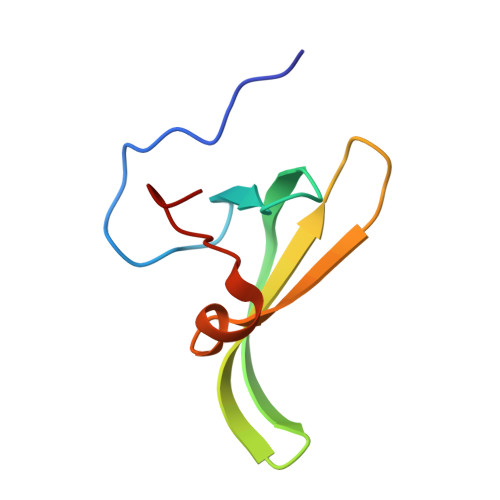Structure-Function Dissection of Myxococcus xanthus CarD N-Terminal Domain, a Defining Member of the CarD_CdnL_TRCF Family of RNA Polymerase Interacting Proteins.
Bernal-Bernal, D., Gallego-Garcia, A., Garcia-Martinez, G., Garcia-Heras, F., Jimenez, M.A., Padmanabhan, S., Elias-Arnanz, M.(null) PLoS One 10: e0121322-e0121322
- PubMed: 25811865
- DOI: https://doi.org/10.1371/journal.pone.0121322
- Primary Citation of Related Structures:
2LT1 - PubMed Abstract:
Two prototypes of the large CarD_CdnL_TRCF family of bacterial RNA polymerase (RNAP)-binding proteins, Myxococcus xanthus CarD and CdnL, have distinct functions whose molecular basis remain elusive. CarD, a global regulator linked to the action of several extracytoplasmic function (ECF) σ-factors, binds to the RNAP β subunit (RNAP-β) and to protein CarG via an N-terminal domain, CarDNt, and to DNA via an intrinsically unfolded C-terminal domain resembling eukaryotic high-mobility-group A (HMGA) proteins. CdnL, a CarDNt-like protein that is essential for cell viability, is implicated in σA-dependent rRNA promoter activation and interacts with RNAP-β but not with CarG. While the HMGA-like domain of CarD by itself is inactive, we find that CarDNt has low but observable ability to activate ECF σ-dependent promoters in vivo, indicating that the C-terminal DNA-binding domain is required to maximize activity. Our structure-function dissection of CarDNt reveals an N-terminal, five-stranded β -sheet Tudor-like domain, CarD1-72, whose structure and contacts with RNAP-β mimic those of CdnL. Intriguingly, and in marked contrast to CdnL, CarD mutations that disrupt its interaction with RNAP-β did not annul activity. Our data suggest that the CarDNt C-terminal segment, CarD61-179, may be structurally distinct from its CdnL counterpart, and that it houses at least two distinct and crucial function determinants: (a) CarG-binding, which is specific to CarD; and (b) a basic residue stretch, which is also conserved and functionally required in CdnL. This study highlights the evolution of shared and divergent interactions in similar protein modules that enable the distinct activities of two related members of a functionally important and widespread bacterial protein family.
Organizational Affiliation:
Departamento de Genética y Microbiología, Área de Genética (Unidad Asociada al IQFR-CSIC), Facultad de Biología, Universidad de Murcia, Murcia, Spain.














